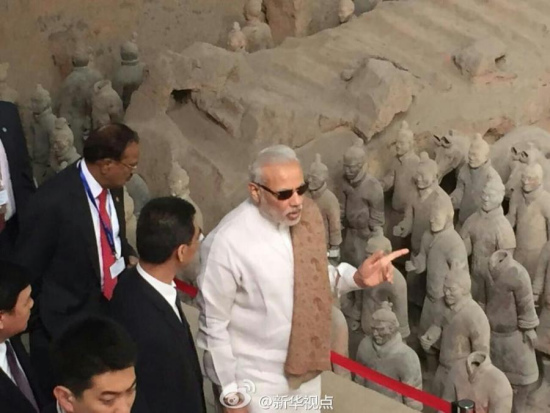
Indian Prime Minister Narendra Modi visits the Terracotta Warriors at Emperor Qinshihuang's Mausoleum Site Museum in Xi'an, capital of Shaanxi province, May 14, 2015. (Photo/Weibo of Xinhua News Agency)
After Indian Prime Minister Narendra Modi hosted Chinese President Xi Jinping in his home state of Gujarat last September, Xi returned the favor by offering Modi a visit to his family origin of Shaanxi on Thursday.
The exchange of visits by the leaders from the world's two largest emerging economies soon after both took office has signaled warming relations between the two oriental giants.
It is not quite often for top Chinese leaders to travel outside Beijing to meet foreign guests. The tour of the ancient Xi'an City, a place closely connected to China and India's deep historical links, was a carefully orchestrated choice.
Eminent Chinese monk Xuan Zang in the Tang Dynasty (618-907) went by Gujarat during his trip to India to seek Buddhist scriptures, bringing the sutras back to Xi'an and disseminating the Buddhist doctrines there.
Despite the long-standing history of cultural exchange between the two neighboring ancient civilizations which now share similar national conditions and a common aspiration for prosperity, Sino-Indian ties have long been regarded as sometimes complicated due to their competitive yet cooperative relationship.
For the past few decades, there has been mistrust between China and India, resulting in tense relations and even military confrontation over border issues in 1962.
However, "not a single bullet" has been fired on the border for the last quarter century and the two countries have shown "great maturity" and are committed to "economic cooperation," as Modi described in an interview with Time magazine before his China tour.
With growing economic integration and people-to-people contact in recent years, the two Asian economies have ushered in a new phase and the Sino-Indian ties could be among the most important bilateral relationships, requiring the two powers to abandon the outdated zero-sum mindset and build a more constructive relationship.
It is clear that if the "Chinese Dragon" and the "Indian Elephant" co-exist harmoniously and realize peaceful, cooperative development, it will bring benefit to not only their combined 2.5 billion people, but also those living beyond their borders. Otherwise, both might slow down their growth if they fall into a spiral of bilateral rivalry.
It would be better for the two economies to go beyond containment and seize the noticeable synergies thanks to their complementary industries.
China is an infrastructure powerhouse, while India has infrastructure deficits. China can help India upgrade its railway stations and overhaul its high-speed rail networks, and, consequently, the two economies would both get a big boost.
India has created world-class software and competitive pharmaceutical industries, but it has never achieved the take-off in manufacturing which prospered in China in the past decades. If the two can conduct pragmatic cooperation, both can benefit.
China is India's largest trading partner, while India is China's biggest in South Asia, with two-way trade totaling about 65.5 billion U.S. dollars in 2013. Although India's trade deficit with China has soared, the latter has pledged to import more Indian pharmaceuticals and agricultural products to balance bilateral trade.
This is a chance for the two Asian neighbors to consolidate trust. The world's two largest developing countries should become global partners for strategic coordination and jointly strive for a just and equitable international order.
"If we speak with one voice, the whole world will listen, and if we join hands, the whole world will pay attention," Xi told Modi in his visit to India.
















































